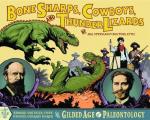|
This section contains 376 words (approx. 2 pages at 300 words per page) |
Encyclopedia of World Biography on Othniel Charles Marsh
The American paleontologist Othniel Charles Marsh (1831-1899) discovered extinct birds with teeth, the Dinocerata, a kind of missing link between the reptiles and the birds, and traced the development of the modern horse.
On Oct. 29, 1831, O. C. Marsh was born in Lockport, N. Y. He graduated from Yale College in 1860. In 1860-1861 he pursued graduate studies in the Yale Scientific School and then spent 3 years in study at Berlin, Breslau, and Heidelberg. In 1866 he was appointed to the chair of paleontology at Yale, the first such chair to be established in America. Marsh held this position, which carried no teaching duties and no salary until 1896, for the rest of his life. He was aided financially by an inheritance from his uncle George Peabody, whom he induced to establish the Peabody Museum at Yale, which Marsh headed.
In 1870 Marsh organized the first of his Yale scientific expeditions, to the fossil-rich West. The first year they explored the Pliocene deposits of Nebraska and the Miocene of northern Colorado, crossed over the Bridger Basin in Wyoming, and then went southward into California. A succession of such expeditions followed throughout the 1870s. Marsh published his findings in a series of volumes on toothed birds and North American dinosaurs.
In 1882, following a major reorganization of the Federal surveys, Marsh was appointed vertebrate paleontologist to the U. S. Geological Survey. This position gave him first choice of the wealth of specimens being brought in by government surveying parties. Thereafter the fossils came into his museum faster than he could study them, and an immense pile remained unclassified at his death.
Marsh is given credit for putting the collection and preparation of vertebrate fossils upon a truly scientific basis. Always a careful worker, he was responsible for the complete reconstruction of a great many extinct animals, including a large number of dinosaurs found near Laramie, Wyo., the greatest dinosaur boneyard in the world.
Despite his nasty temperament and his often unscrupulous means of dealing with rivals and subordinates, Marsh was widely honored in the scientific world. He was president of the prestigious National Academy of Sciences (1883-1895), and he received the Bigsby Medal from the Geological Society of London (1877) and the Cuvier Prize from the French Academy. He died on March 18, 1899.
|
This section contains 376 words (approx. 2 pages at 300 words per page) |


